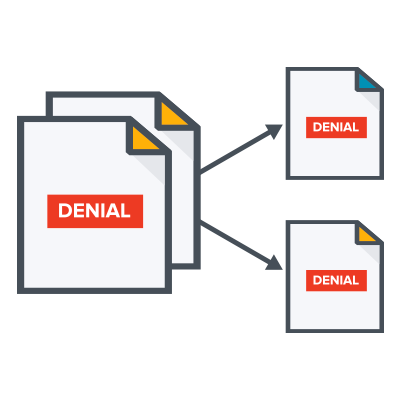- Solutions
Healthcare
- Resources
Why run this play?
To accelerate cash and reduce denials, bad debt, and other uncollectible or doubtful accounts, it helps to reshape the A/R first. This provides a clearer picture of the true Net Collectible Value (NCV) of your receivables. Staff can improve results-oriented touches by focusing on account inventory with a higher propensity to convert into cash.
Background
835 files contain significant amounts of denial information, some complex, while some are simpler. We have identified a few denial types that can be quickly worked to bring the account to closure or move balances into other resolution categories, such as self pay, charity, or write-off (payer-specific processes exist here). In this play, we focus on three denial types:
Benefits Exhausted
Missing Referral
Missing Medicare ABN
Take Action
- Create a report off your most recent 835 remits for each account number. Review all adjustments for Benefits Exhausted, Missing Referral, and Missing Medicare ABN. Put these reports into the scheduler to be distributed to the responsible individual(s) on a daily basis.
- For claims that are denied for Benefits Exhausted, depending on the payer, the exhausted balances should be written off according to your write-off policies and procedures, including charity or uncompensated care. In other cases, the amount is billed to the secondary payers or the guarantor/patient.
- For Missing Referral, create a report for all qualifying denied claims by admitting physician. Have the appropriate leader talk to the physician practice management team and/or talk to the service department to change their practice and reschedule all patients for whom no referral exists. We also recommend running a report for Missing Referral by Location and by Total Denied Dollars. Use your findings to enforce the protocol that does not allow scheduling a patient without a referral.
- For Missing Medicare ABN, segment your data by ER vs. non ER. Research if the ABN was necessary – if yes and it was not secured, and it was not an ER patient type, the account’s propensity for any payment drops dramatically and should most likely written off. If the ABN was not necessary, and the procedure was medically necessary, then re-submit according to your medical necessity appeal procedures. Or if a payable diagnosis is indicated in the patient's encounter/service notes or record, correct the diagnosis and resubmit the claim.
Want to see how to run this play in VisiQuate?
Request a demoHow to Calculate This Play's Value
The returns for A/R reshaping plays come in many forms:
1. Reduced Cost to Collect and fewer Total Touches to Resolve (TTR). Each reduction of a downstream wasted touch provides a savings of $2.50 - $4.00 in fully loaded labor costs, based on geography and salary structure. Multiplied over a large A/R, this creates a staff reduction or reallocation opportunity.
2. By rapidly identifying uncollectible accounts, the sustainable ongoing reduction in days can be fairly stated as cash acceleration, with the associated increase being the interest income on the infusion of cash.
3. Insurance account representatives (portfolio consultants) can combine large pools of uncollectibles and remove them from the A/R with less manual intervention. This lets them engage the A/R on more meaningful touches (and an increase in total volume of touches by working accounts that are easier to convert).
ROI for Gross Clients: [((Difference between A/R on Play Go Live date and Current Date) * ENR% (or if no ENR % then by 32%)) * 5%]
ROI for Net Clients: [(Difference between A/R on Play Go Live date and Current Date) * 5%]
Be the first to know when a new play comes out.
Sign up now!© 2025 VisiQuate, Inc. All Rights Reserved.









